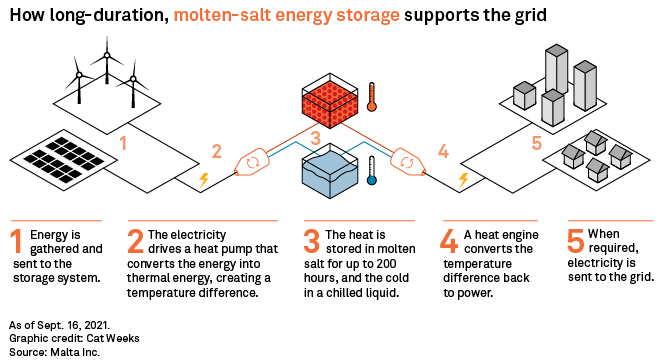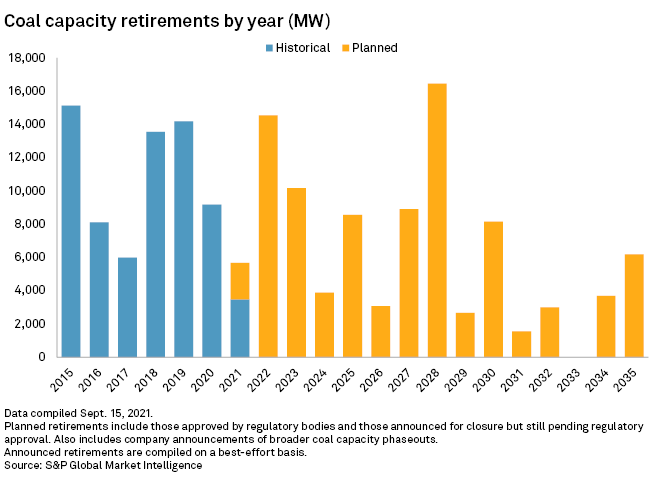S&P Global Offerings
Featured Topics
Featured Products
Events
S&P Global Offerings
Featured Topics
Featured Products
Events
S&P Global Offerings
Featured Topics
Featured Products
Events
Banking & Capital Markets
Economy & Finance
Energy Transition & Sustainability
Technology & Innovation
Podcasts & Newsletters
Banking & Capital Markets
Economy & Finance
Energy Transition & Sustainability
Technology & Innovation
Podcasts & Newsletters
S&P Global Offerings
Featured Topics
Featured Products
Events
20 Sep, 2021
By Karin Rives

| Xcel Energy's Hayden power plant in northwestern Colorado may be retrofitted with energy storage to support the utility's rapid investment in renewables. Source: Jeffrey Beall/Flickr |
Power generators spent heavily on coal-fired generation over decades. But as coal becomes more of an environmental and financial liability, many plants are slated to close — leaving companies to decide what to do with these assets.
U.S. utilities will shed nearly 93 GW of coal-fired generation between 2021 and 2035, S&P Global Market Intelligence data shows. Now, some companies are testing a novel idea: turning their retired coal-fired plants into massive clean energy battery banks to support a rapid build-out of intermittent solar and wind farms.
By reusing existing infrastructure, utilities can potentially save some local jobs and tax revenue for towns that struggle with plant closures. Economic stability is a priority for politicians navigating the transition to cleaner energy.
The biggest draw for utilities, however, is the recent introduction of vastly more efficient long-duration storage options.
Xcel Energy Inc. is considering retrofitting one unit at its Hayden coal plant in northwestern Colorado with energy storage that uses molten salt. An already-tried technology at concentrating solar plants, the salt can retain heat and energy for many more hours than traditional lithium batteries do.
If built, the system would store up to 150 MW of electricity for at least 10 hours, said Xcel spokeswoman Michelle Aguayo.
"The first thing Xcel told me is that they're looking at asset retention," recalled Tim Redmond, a county commissioner whose district includes Xcel's 441-MW Hayden coal plant slated to retire in 2028. "They want to keep the station there, keep it operating."

Across the country in North Carolina, Duke Energy Corp. is planning to test a similar idea at one of its coal plants. Duke recently teamed up with Alphabet Inc.'s spinoff Malta Inc. to explore molten salt storage that could eventually be scaled up for use at other sites in the utility's service territory.
An up-and-coming startup, Malta is developing systems capable of storing energy for up to 200 hours. The electricity can then be easily dispatched back to the grid when demand peaks or renewable generation dips.
"It could be a game-changer," said Duke Energy spokesperson Valerie Patterson. The utility is looking at a range of technologies to meet its carbon reduction goals, including having a 23% clean energy portfolio by 2030. "We do have a commitment to serve our customers with reliable power 24/7," Patterson said.
Duke expects to retire 6,370 MW of coal-fired capacity between 2021 and 2028 but does not plan to retire its last coal-fired plant until 2048. That is more than a decade beyond U.S. President Joe Biden's goal to decarbonize the utility sector by 2035 to help slow climate change.
At the same time, announced coal plant retirements are accelerating industry-wide, new data from Market Intelligence shows.

Duke and Malta are conducting a one-year pilot study and expect to decide in 2022 whether to build a North Carolina energy storage project and, if so, where. Using an existing plant makes sense because the storage system would operate as a conventional power plant and use infrastructure that is already in place, Patterson said. It would also help the company retain workers it can ill-afford to lose.
"As new and emerging technology comes into play, we still need to have people who can operate those assets," Patterson said. "We're looking at keeping them employed, to maintain that institutional knowledge, to meet our future needs as well."
It is now up to industry
Long-duration storage is the "lagging piece" of the clean energy puzzle, said Kerry Rippy, a Colorado-based thermal renewable researcher. Without it, solar energy cannot live up to its potential.
Molten salt storage is one of several technologies Rippy predicts will grow, not just to accommodate renewables but also to store solar heat in the production of hydrogen and ammonia. When scaled for grid needs, the technology should be cost-competitive with the lithium batteries that are already widely in use.
"The systems definitely work, it's just a matter of bringing the cost down and getting industry to use it," Rippy said.
Besides energy storage, the old plant site may sport a hydrogen production facility and a biomass power plant that would burn spruce and lodgepole pine killed by beetles, along with other waste streams. The dead trees would be shipped in from across the state via rail spurs once used to bring in coal.
Xcel is also in talks with Colorado Parks and Wildlife about turning a large pond by the plant into a fish hatchery, Redmond said. "My hope, quite possibly, in the end, is to get more jobs there than we originally had."
